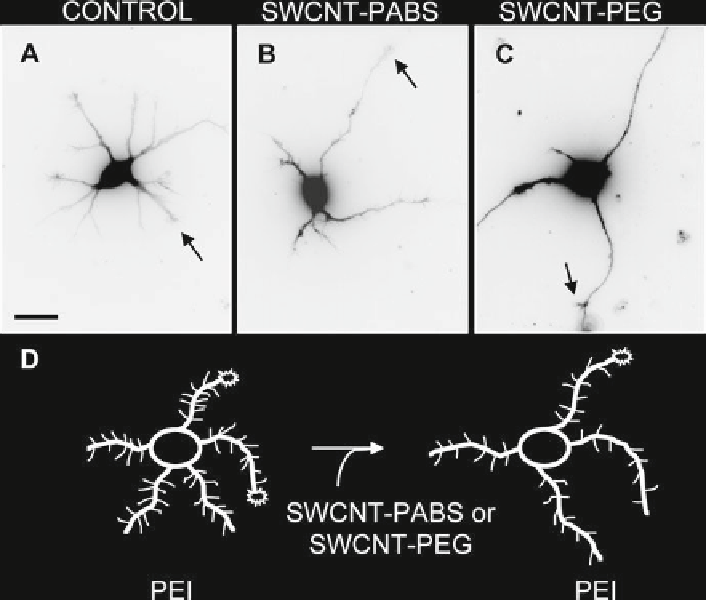Biomedical Engineering Reference
In-Depth Information
Fig. 4
Chemically functionalized water-soluble SWCNTs added to the culture medium modulate
neurite outgrowth. Fluorescence images of live hippocampal neurons, accumulating the vital stain,
calcein. Neurons grown on PEI-coated glass coverslips (
a
; control, sham treated) can be treated
with water-soluble CNTs (each at 1 mg/mL), either SWCNT-PABS (
b
) or SWCNT-PEG (
c
) to
affect their growth characteristics. Arrows indicate growth cones. Scale bar, 20 m m. (
d
) Drawing
summarizing the effects of water-soluble SWCNTs on neurite outgrowth and growth cones. Water-
soluble SWCNT-PABS or SWCNT-PEG graft copolymers when added to the culturing medium of
neurons grown on PEI substrate increased the length of selected neurites and reduced the number
of growth cones. Modifi ed from (Ni et al.
2005
)
neurons and found no signifi cant differences in the dye load in neurons at rest that
were exposed to the different concentrations of SWCNT-PEG. This indicated that
constitutive membrane recycling was not affected by SWCNT-PEG. However, data
indicated that SWCNT-PEG inhibited depolarization-dependent load of the dye
(Malarkey et al.
2008
). Subsequent experiments indicated that the inhibitory action of
SWCNT-PEG was preferentially affecting regulated endocytosis. Hence, the exocy-
totic incorporation of vesicles into the plasma membrane was not balanced by the
endocytotic retrieval in the presence of SWCNTs. This could effectively cause the
increase in neurite length observed by Ni et al. (Ni et al.
2005
). It should be noted
that both studies (Ni et al.
2005
; Malarkey et al.
2008
) were done by the same group
under the same experimental conditions. The reduction of depolarization-dependent

